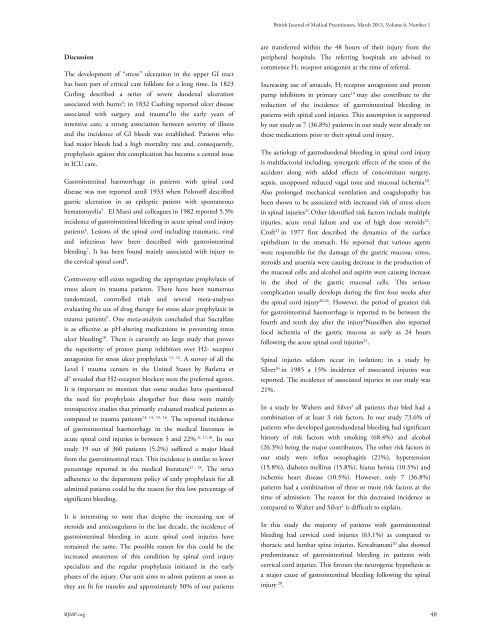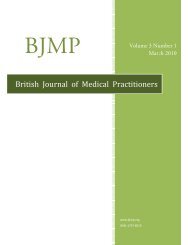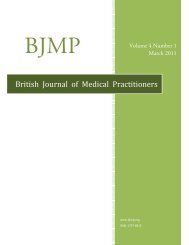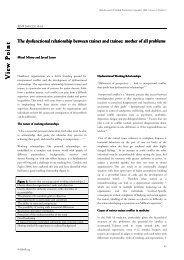R esearch A rticle - British Journal of Medical Practitioners
R esearch A rticle - British Journal of Medical Practitioners
R esearch A rticle - British Journal of Medical Practitioners
Create successful ePaper yourself
Turn your PDF publications into a flip-book with our unique Google optimized e-Paper software.
<strong>British</strong> <strong>Journal</strong> <strong>of</strong> <strong>Medical</strong> <strong>Practitioners</strong>, March 2013, Volume 6, Number 1<br />
Discussion<br />
The development <strong>of</strong> “stress” ulceration in the upper GI tract<br />
has been part <strong>of</strong> critical care folklore for a long time. In 1823<br />
Curling described a series <strong>of</strong> severe duodenal ulceration<br />
associated with burns 3 ; in 1832 Cushing reported ulcer disease<br />
associated with surgery and trauma 4 In the early years <strong>of</strong><br />
intensive care, a strong association between severity <strong>of</strong> illness<br />
and the incidence <strong>of</strong> GI bleeds was established. Patients who<br />
had major bleeds had a high mortality rate and, consequently,<br />
prophylaxis against this complication has become a central issue<br />
in ICU care.<br />
Gastrointestinal haemorrhage in patients with spinal cord<br />
disease was not reported until 1933 when Polstorff described<br />
gastric ulceration in an epileptic patient with spontaneous<br />
hematomyelia 5 . El Marsi and colleagues in 1982 reported 5.5%<br />
incidence <strong>of</strong> gastrointestinal bleeding in acute spinal cord injury<br />
patients 6 . Lesions <strong>of</strong> the spinal cord including traumatic, viral<br />
and infectious have been described with gastrointestinal<br />
bleeding 7 . It has been found mainly associated with injury to<br />
the cervical spinal cord 8 .<br />
Controversy still exists regarding the appropriate prophylaxis <strong>of</strong><br />
stress ulcers in trauma patients. There have been numerous<br />
randomized, controlled trials and several meta-analyses<br />
evaluating the use <strong>of</strong> drug therapy for stress ulcer prophylaxis in<br />
trauma patients 9 . One meta-analysis concluded that Sucralfate<br />
is as effective as pH-altering medications in preventing stress<br />
ulcer bleeding 10 . There is currently no large study that proves<br />
the superiority <strong>of</strong> proton pump inhibitors over H2- receptor<br />
antagonists for stress ulcer prophylaxis 11, 12 . A survey <strong>of</strong> all the<br />
Level I trauma centers in the United States by Barletta et<br />
al 9 revealed that H2-receptor blockers were the preferred agents.<br />
It is important to mention that some studies have questioned<br />
the need for prophylaxis altogether but these were mainly<br />
retrospective studies that primarily evaluated medical patients as<br />
compared to trauma patients 13, 14, 15, 16 . The reported incidence<br />
<strong>of</strong> gastrointestinal haemorrhage in the medical literature in<br />
acute spinal cord injuries is between 5 and 22% 6, 17,18 . In our<br />
study 19 out <strong>of</strong> 360 patients (5.2%) suffered a major bleed<br />
from the gastrointestinal tract. This incidence is similar to lower<br />
percentage reported in the medical literature 17, 18 . The strict<br />
adherence to the department policy <strong>of</strong> early prophylaxis for all<br />
admitted patients could be the reason for this low percentage <strong>of</strong><br />
significant bleeding.<br />
It is interesting to note that despite the increasing use <strong>of</strong><br />
steroids and anticoagulants in the last decade, the incidence <strong>of</strong><br />
gastrointestinal bleeding in acute spinal cord injuries have<br />
remained the same. The possible reason for this could be the<br />
increased awareness <strong>of</strong> this condition by spinal cord injury<br />
specialists and the regular prophylaxis initiated in the early<br />
phases <strong>of</strong> the injury. Our unit aims to admit patients as soon as<br />
they are fit for transfer and approximately 50% <strong>of</strong> our patients<br />
are transferred within the 48 hours <strong>of</strong> their injury from the<br />
peripheral hospitals. The referring hospitals are advised to<br />
commence H2 receptor antagonist at the time <strong>of</strong> referral.<br />
Increasing use <strong>of</strong> antacids, H2 receptor antagonists and proton<br />
pump inhibitors in primary care 19 may also contribute to the<br />
reduction <strong>of</strong> the incidence <strong>of</strong> gastrointestinal bleeding in<br />
patients with spinal cord injuries. This assumption is supported<br />
by our study as 7 (36.8%) patients in our study were already on<br />
these medications prior to their spinal cord injury.<br />
The aetiology <strong>of</strong> gastroduodenal bleeding in spinal cord injury<br />
is multifactorial including, synergetic effects <strong>of</strong> the stress <strong>of</strong> the<br />
accident along with added effects <strong>of</strong> concomitant surgery,<br />
sepsis, unopposed reduced vagal tone and mucosal ischemia 20 .<br />
Also prolonged mechanical ventilation and coagulopathy has<br />
been shown to be associated with increased risk <strong>of</strong> stress ulcers<br />
in spinal injuries 21 .Other identified risk factors include multiple<br />
injuries, acute renal failure and use <strong>of</strong> high dose steroids 22 .<br />
Cr<strong>of</strong>t 23 in 1977 first described the dynamics <strong>of</strong> the surface<br />
epithelium in the stomach. He reported that various agents<br />
were responsible for the damage <strong>of</strong> the gastric mucosa; stress,<br />
steroids and uraemia were causing decrease in the production <strong>of</strong><br />
the mucosal cells; and alcohol and aspirin were causing increase<br />
in the shed <strong>of</strong> the gastric mucosal cells. This serious<br />
complication usually develops during the first four weeks after<br />
the spinal cord injury 20,24 . However, the period <strong>of</strong> greatest risk<br />
for gastrointestinal haemorrhage is reported to be between the<br />
fourth and tenth day after the injury 8 Nuseilben also reported<br />
focal ischemia <strong>of</strong> the gastric mucosa as early as 24 hours<br />
following the acute spinal cord injuries 25 .<br />
Spinal injuries seldom occur in isolation; in a study by<br />
Silver 26 in 1985 a 15% incidence <strong>of</strong> associated injuries was<br />
reported. The incidence <strong>of</strong> associated injuries in our study was<br />
21%.<br />
In a study by Walters and Silver 1 all patients that bled had a<br />
combination <strong>of</strong> at least 3 risk factors. In our study 73.6% <strong>of</strong><br />
patients who developed gastroduodenal bleeding had significant<br />
history <strong>of</strong> risk factors with smoking (68.4%) and alcohol<br />
(26.3%) being the major contributors. The other risk factors in<br />
our study were reflux oesophagitis (21%), hypertension<br />
(15.8%), diabetes mellitus (15.8%), hiatus hernia (10.5%) and<br />
ischemic heart disease (10.5%). However, only 7 (36.8%)<br />
patients had a combination <strong>of</strong> three or more risk factors at the<br />
time <strong>of</strong> admission. The reason for this decreased incidence as<br />
compared to Walter and Silver 1 is difficult to explain.<br />
In this study the majority <strong>of</strong> patients with gastrointestinal<br />
bleeding had cervical cord injuries (63.1%) as compared to<br />
thoracic and lumbar spine injuries. Kewalramani 20 also showed<br />
predominance <strong>of</strong> gastrointestinal bleeding in patients with<br />
cervical cord injuries. This favours the neurogenic hypothesis as<br />
a major cause <strong>of</strong> gastrointestinal bleeding following the spinal<br />
injury 20 .<br />
BJMP.org<br />
40







